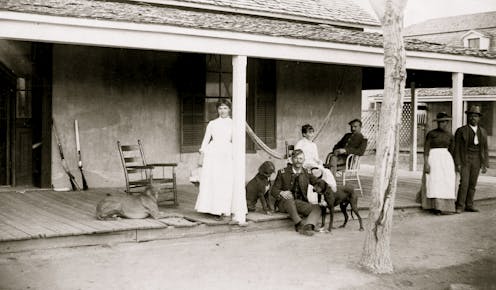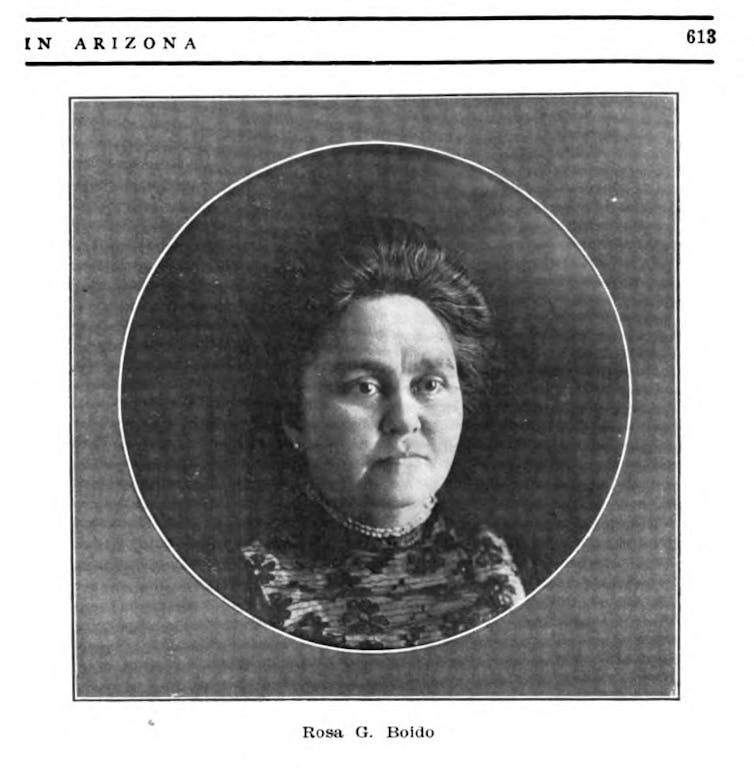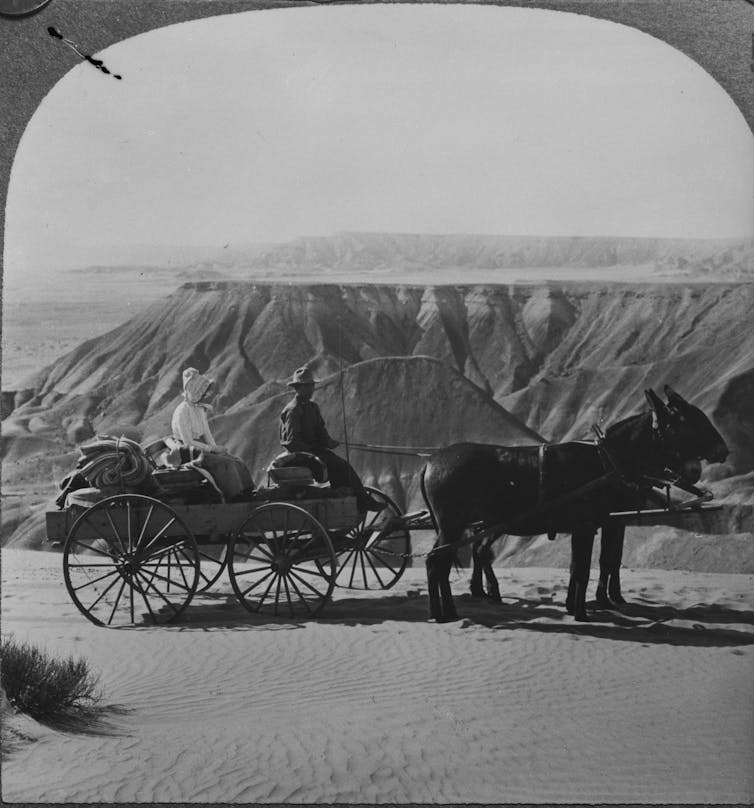Arizona’s 1864 abortion law was made in a women’s rights desert – here’s what life was like then
Abortions happened in Arizona, despite a near-complete abortion ban enacted in 1864. But people also faced penalties for them, including a female doctor who went to prison.

Dora Juhl, a 15-year-old teenager, walked into Dr. Rosa Goodrich Boido’s obstetrical practice in Phoenix in January 1918. Juhl wanted to end her pregnancy.
But abortion was illegal in Arizona.
Boido, the city’s sole female physician, asked Juhl for US$100 – about $2,000 today – to perform the abortion.
Juhl said she could pay $27 – her entire savings – but Boido explained the legal risks, including the prison time she could face, and insisted on full payment. Juhl left the office, then tried to give herself an abortion and returned to Boido’s practice in physical distress.
Boido then admitted Juhl as a patient. It is unclear whether Boido performed an abortion, removed fetal tissue, or merely gave her pain medication. The next day, police arrived and arrested Boido. Arizona charged Boido under a 54-year-old law banning abortions. She lost her medical license and spent three months in jail with bail set at $15,000 – about $300,000 today – before her trial.
Those days may soon return to Arizona.
The Arizona Supreme Court ruled on April 9, 2024, that this same 160-year-old territorial law that bans abortion – unless the pregnant person’s life is in danger – will go into effect.
Since that ruling, the Arizona Legislature has been grappling with how to handle the near-total ban. After several weeks of attempts, the state House of Representatives passed a repeal of the law on April 24, 2024, that now goes to the state Senate for debate and a vote. But even if the ban is fully repealed, it could still take temporary effect this summer.
Passed during the Civil War in 1864, this law mandated that anyone who used medicine or surgery “to procure the miscarriage of any woman then being with child, and shall be thereof duly convicted, shall be punished by imprisonment in the Territorial prison for a term not less than two years nor more than five years.”
The sole exception was a physician who “deems it necessary to produce the miscarriage of any woman in order to save her life.”
In the late 1800s, women in Arizona, as in other places in the U.S., had no direct say in laws governing their bodies. As someone who teaches history in Arizona and researches slavery, I think it is useful to understand what life was like in Arizona when this abortion ban was in force.

A women’s rights desert
In 1864, Arizona – which was an official territory of the United States – was a vast desert.
In the 1870s, Arizona had less than 10,000 residents, excluding Native Americans, whom the Census refused to count and the U.S. refused to grant citizenship.
Most women living in territorial Arizona were Diné, meaning Navajo, or Chiricahua Apache. In 1864, the U.S. Army was fighting Indigenous people in an effort to take Native lands. U.S. forces crowded Apaches onto reservations in Arizona and New Mexico.
All women in Arizona could not vote, serve on juries or exercise full control over property in a marriage. Demographically, the territory had a pronounced gender imbalance in favor of men – women were just one-quarter of the non-Native population.
Most of the white men in Arizona moved there to work as miners and soldiers. People there also worked on cattle ranches and grew cotton. Mining and ranching interests controlled politics, and many Arizonans supported the Southern Confederacy, though Arizona was a free territory in 1863, meaning slavery was not legal.
Many politicians in Arizona, like House Speaker William Claude Jones, were transplants from the South.
Jones was responsible for shepherding the abortion ban through the Legislature. Around this time, Jones abandoned his first wife. Throughout his life, he would have three more wives, including a 12-year-old, a 15-year-old and a 14-year-old at the time of their weddings.
Women’s rights in territorial Arizona
Women had few basic rights in Arizona before it became a state in 1912. And territorial law did not favor women.
Hispanic and African American women had even fewer rights than white women. Arizona punished anyone who kidnapped a Black person for the purpose of selling them into slavery. But, at the same time, it outlawed “all marriages of white persons with negroes or mulattoes.”
Until 1871, a wife who divorced a husband for adultery faced the prospect of a court-appointed trustee to oversee the property or alimony she received.
But if a wife was found to have committed adultery, she lost all her property to her husband, forever. The 1871 Married Woman’s Property Act granted women more autonomy, but marriage remained an unequal partnership.
By around 1870, women’s suffragists began advocating for Arizona to follow Wyoming, Colorado and Utah in giving women the right to vote. This was 50 years before the 19th Amendment gave the right to vote to all women in the U.S.
Led by female attorney Murat Masterson, suffragists introduced a bill to enfranchise women in 1883. It failed. White women were allowed to cast ballots in county school board elections, but it took determined activism by women’s rights activists to achieve even this vote.
Suffragists led by Pauline O’Neill, Frances Willard Munds and others continued to push for the right for women to vote through organized clubs and staged rallies – and worked to sway pubic opinion.
Women’s health doctor Boido was also active in the women’s suffrage fight in Arizona by promoting sex education, as well as anti-death penalty, anti-alcohol and anti-tobacco efforts.
In 1913, one year after Arizona became a state, women finally got the right to vote.

Getting an abortion in territorial Arizona
Some women like Juhl did indeed violate Arizona’s abortion ban, based on historical evidence of physicians charging a high fee.
After Boido’s arrest and arraignment, she remained in jail for three months, including during her trial. The jury “found her guilty of performing an illegal operation,” according to the Arizona Republican newspaper.
Historian Mary S. Melcher has argued that Boido did not have a jury of her peers since women were not allowed on them.
Juhl returned to her family in Yavapai County and went back to high school.
After her conviction in 1918, Boido became prisoner 5159 at the women’s wing of the state penitentiary. She served two months, then was paroled because the women’s section of the prison was too hot and unlivable in the Arizona summer. With Boido’s medical license gone, she moved to California. She died in Hawaii in 1959 at age 89.
Arizona kept this 1864 abortion ban in place until the U.S. Supreme Court ruled, in Roe v. Wade in 1973, that the right to get an abortion was constitutionally guaranteed. The court reversed Roe v. Wade in 2022, sparking a series of events that have led to the resurrection of the 1864 Arizona abortion ban.
Calvin Schermerhorn does not work for, consult, own shares in or receive funding from any company or organization that would benefit from this article, and has disclosed no relevant affiliations beyond their academic appointment.
Read These Next
Media coverage of campus protests tends to focus on the spectacle, rather than the substance
Analysis shows news stories on pro-Palestinian demonstrations at US universities spiked when they involved…
What’s in a VIN? How to decode the vehicle identification number, your car’s unique fingerprint
VINs can tell a story if you know what to look for.
Animal behavior research is getting better at keeping observer bias from sneaking in – but there’s s
Like all people, the way scientists see the world is shaped by biases and expectations, which can affect…




